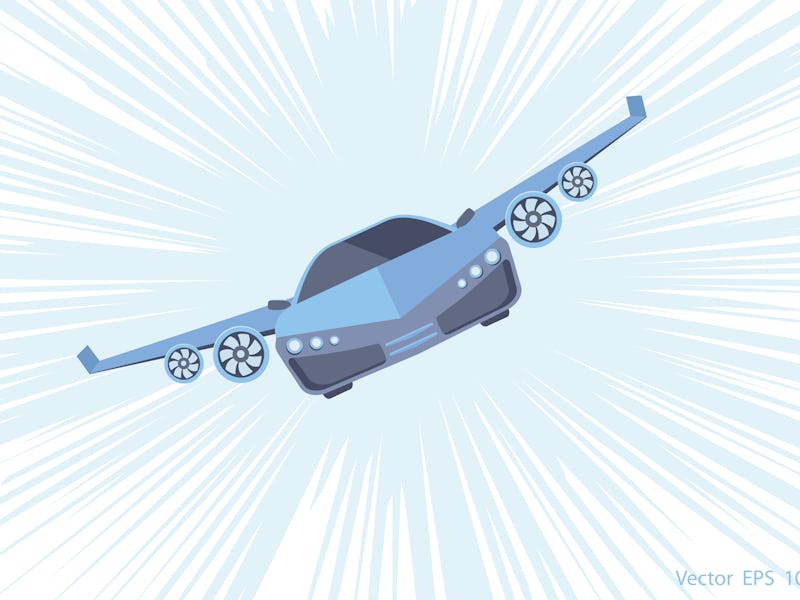Video: These acrobatic robots will help design the flying machines of tomorrow
When it comes to flying, insects know best.

Keeping track of a moth or fly in order to swat it is one of many the banes of human existence. Scientists have now designed a robot that can accurately track these insects, and they're going to do a lot more than be advanced flyswatters.
This super-accurate camera cage works by predicting the motion of moths as they fly through an open environment and moves accordingly on cables to match their flight. The robot, called a lab-on-cables, was able to track moths with up to 90 percent accuracy by predicting its movements.
More than just an advanced fly swatter, scientists say that tracking and learning from these insects can help us design the future of flying robotics.
The study was published this Wednesday in the journal Science Robotics and in it, the team of French computer scientists explains why studying the behavior of insects has been such a difficult scientific question.
"For decades, researchers have developed laboratory experimental setups to study and understand the flight behavior of insects," write the authors. "There are two approaches: one consists of maintaining the insect in position so that flight kinematics can be analyzed in great detail with highspeed cameras, and the other considers more natural conditions, that is, free flight."
Tethering insects, which is the first approach the researchers describe, can lead to unnatural movement and therefore inaccurate analyses. On the other hand, tracking the free flight of insects can be extremely challenging because their movement is unpredictable. Previous research has attempted to solve this problem using virtual reality to mimic an open environment, but this approach still faced the problem of tethering the insect.
To avoid both of these problems, the researchers designed a hands-free robotic tracker that uses quick calculations to stay on top of a moth as it wizzes around a room. This "lab-on-cables" is equipped with cameras and motion trackers.
The lab-on-cables uses different cameras to pinpoint the expected movement of the insect in order to track it through the open environment.
To test the effectiveness of their robot, the team first trained it to track a number of different insects on predetermined paths, such as reactions to different scents. Because different insects have fairly consistent flight behavior in response to different stimuli, this gave the robot an advantage when tracking the insects because it could more easily predict their motion. The researchers report that the robot was able to track 90 percent of these insects with accuracy up to 1 cm -- a pretty good margin for a 30 cm apparatus.
The team also tested the robot on moths and were able to observe minute details of their flight -- such as how they pitch and roll -- without significantly losing track of the insect.
This robotic tracking cage was able to match the insect's movements up to 90 percent of the time.
The researchers write that understanding details of insects flights like this will be an important step toward developing more advanced, flying robotics in the future.
"[The] sensory processing and flight maneuvers [of insects]... are unmatched with current technology, write the authors. "Understanding how miniaturized insect brains control sensory processing and flight behavior could serve as a source of inspiration for future developments in robotics, e.g., micro- aerial vehicles mimicking flapping flight at the insect scale."
While it's possible that these advanced robotics could be used to finally design the flying cars we've all been waiting for, it's more likely that they will be used to perfect search-and-rescue robots and drones used largely for military reconnaissance as well as disaster situations.
Abstract: Flying insects have evolved to develop efficient strategies to navigate in natural environments. Yet, studying them experimentally is difficult because of their small size and high speed of motion. Consequently, previous studies were limited to tethered flights, hovering flights, or restricted flights within confined laboratory chambers. Here, we report the development of a cable-driven parallel robot, named lab-on-cables, for tracking and interacting with a free-flying insect. In this approach, cameras are mounted on cables, so as to move automatically with the insect. We designed a reactive controller that minimizes the online tracking error between the position of the flying insect, provided by an embedded stereo-vision system, and the position of the moving lab, computed from the cable lengths. We validated the lab-on-cables with Agrotis ipsilon moths (ca. 2 centimeters long) flying freely up to 3 meters per second. We further demonstrated, using prerecorded trajectories, the possibility to track other insects such as fruit flies or mosquitoes. The lab-on-cables is relevant to free-flight studies and may be used in combination with stimulus delivery to assess sensory modulation of flight behavior (e.g., pheromone-controlled anemotaxis in moths).